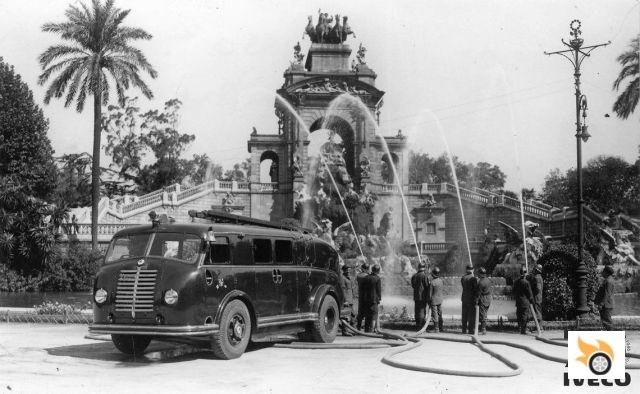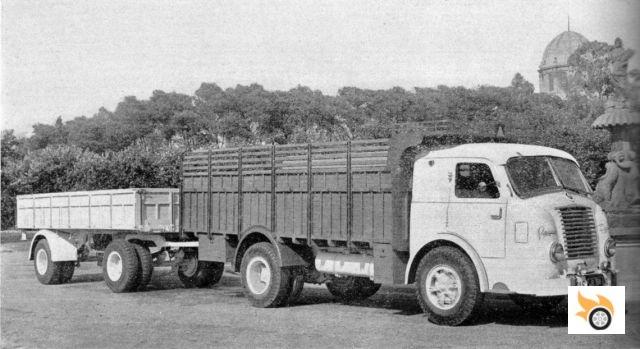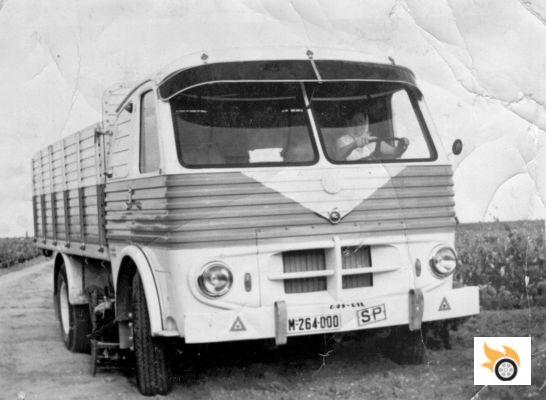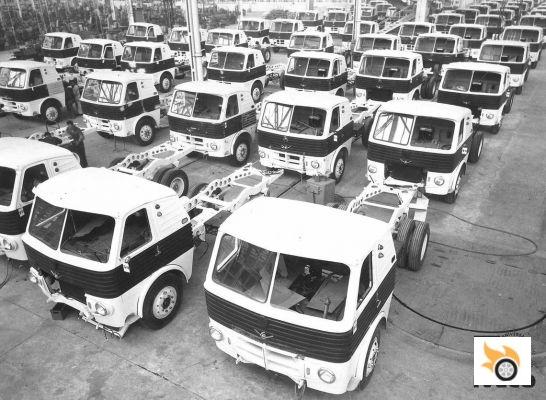Even more exclusive and aimed at a diametrically opposite public, Pegaso also manufactured its own sports car, the Pegaso Z-102. In this case I can understand that many of you don't know it: it appeared on the market in 1951 with a plan to manufacture about 200 chassis per year. In 1959 the project was cancelled after having manufactured only 84 units, including in this figure even some special units manufactured expressly to be shown in some international show or to beat some speed record and that due to its special homologation had to be destroyed once their "work" was finished.
Undoubtedly, Pegaso vehicles are part of the life of a whole generation of Spaniards who, watching their trucks and buses, were involuntary witnesses of the evolution in the means of transport for both goods and passengers.
Now that the Spanish brand is 70 years old, I allow myself the luxury of writing this article that will make me remember so many moments of my youth in which there was always a Pegaso around. I will do it with the utmost respect to the brand, to the different organizations and to the different political ideologies that I will mention, but also trying at all times to tell things as they have been, because among so many lights there were also some shadows that today it seems that they still want to make up. So, having clarified this, I will now tell the story of the most emblematic moments and models of the brand. As you can imagine, it would be totally impossible for me to detail each of the variants that were manufactured of each model.
The end of Hispano-Suiza is the beginning of ENASA
The beginnings of Pegaso as a brand can be traced back to the political ups and downs during the last years of its existence suffered by the extinct Hispano-Suiza, a well-known luxury car brand and less known for its industrial vehicles or its aviation engines. Once the second republic was established in Spain, in April 1931, the then King of Spain, Don Alfonso de Borbón y Habsburgo-Lorena (aka Alfonso XIII) had to go into exile, losing the Hispano-Suiza brand to the one who was its greatest benefactor.
In addition, the new government forced the manufacturer to replace the Spanish flag present on the shield of their cars for a new Republican flag, which negatively affected the "image" of their cars and had a negative impact on their sales in our country while the Hispano-Suiza made in France continued to enjoy the previous prestige. Another factor that had a negative influence on the production of the Hispano-Suiza was the Republican government's obstacles to the importation of the raw materials necessary for the manufacture of these luxury cars.
From this point on, it is important that all the names and organizations that I will be mentioning about the pre-war period are clear, because it will help you to better understand what happened once the Spanish Civil War was over.
Some difficult years began for Hispano-Suiza and for the manufacture of vehicles in its factory in Barcelona or Guadalajara, which worsened when the latter was sold to what today is Fiat S.p.A. At the end of 1935, Damián Mateu, the person who with his hard work and tension had been the architect of giving Hispano-Suiza the image and importance that it still has today, passed away. He was succeeded by his son Miguel Mateu who, to put it politely, did not have the personality of his father. Added to this was the fact that at that time the pre-war atmosphere that was to lead to the Spanish Civil War was already in the air in Spain.
Coinciding with the military uprising of July 1936, the National Confederation of Labour (CNT) seized the company that later the Government of the Generalitat of Catalonia, led by Lluis Companys, would nationalise by decree, legalising the workers' management of the same committee of workers that would later assassinate the administrator Manuel Lazaleta. The leader Miguel Mateu tried to flee to France but was detained at the border, although with the intervention of the French consul he was released and went into exile in France, from where he planned to manufacture military aviation for Francisco Franco's side at the Seville factory.
Once the civil war was over, Francisco Franco entered the streets of Madrid aboard a Hispano-Suiza and Miguel Mateu, with the help of the Swiss engineer Marc Birkigt, one of the founders of the brand, set out to recover the lost prestige with the recovery of the Barcelona factory. The Guadalajara factory (which had been sold to Fiat S.p.A.) could not be recovered because it was totally dismantled. Nevertheless, they quickly started to develop a new model of truck, the Tipo 66, and a new cannon, although the Spanish Hispano-Suiza and the French Hispano-Suiza were already in a process of separation.
At this point, with Miguel Mateu dividing his time between the presidency of Hispano-Suiza and the presidency of the board of directors of the pension fund La Caixa, it was decided to divide the brand into three clearly differentiated areas that would also have their own identity at the administrative level. The first of the sub-companies was dedicated to the construction of military equipment, the second to the production of machines and tools and the third, the one that interests us most in this article, to the manufacture of vehicles and lorries.
In 1944 the Hispano-Suiza 66G truck was launched on the market and was very well received thanks to the possibility of adapting bus, trolleybus, van and even four-wheel drive truck bodies on its chassis. Two passenger cars that had already been manufactured before the civil war, the T49 and the T60, were also relaunched. However, the reception of the passenger cars in an impoverished Spain was not as expected and in 1945 they stopped being manufactured and the business was focused on trucks. In addition, this year saw the definitive separation between the Spanish and French subsidiaries.
The obstacles that Francisco Franco's government imposed on the import of raw materials in an increasingly isolated Spain on an international level put a brake on the expansion plans of Hispano-Suiza, which began to lose money, which posed a serious problem to a government that neither wanted to lose the opportunity to develop industrial vehicles nor could afford it.
Finally, in 1946, Franco's government nationalized the company Hispano-Suiza after a period of threats and pressure that ended with the sale of the company to the newly created National Institute of Industry (INI), which kept both the factories and the patents of Hispano-Suiza to exploit them under the name of Empresa Nacional de Autocamiones, S.A. (ENASA). (ENASA). However, Mr. Miguel Mateu kept his position as chairman of the board of directors of what is now CaixaBank.

ENASA and "el Mofletes".
Once the new brand was created, INI put Wilfredo Ricart, a Catalan engineer with recognized studies in automotive and aeronautics that he had developed working for Alfa Romeo, in charge of it. This appointment was proposed by the president of INI, Juan Antonio Suances, who was also a major general of the naval engineers.
To start manufacturing trucks, ENASA took directly the development of the Hispano-Suiza Type 66G and started selling it as Hispano Pegaso I (because Pegaso as a brand had not yet been created). In any case, this vehicle will always be remembered as "the Cheeks" because of the peculiar shape of the cab. Also peculiar was the fact that they had the steering wheel on the right. This truck had a discreet petrol engine, enough to move the vehicle along our roads, but the fuel consumption was very high, it could reach 50 (fifty) litres per hundred kilometres. As if that were not enough, it quickly began to be known various failures such as the cylinder head gasket or segments.
The first vehicle under the Pegaso brand was shown at the 1947 Barcelona Motor Show and was marketed as Pegaso II. However, the construction of the chassis was improved to homologate a load of up to 8 tons and the cylinder head problems of the first units were solved.

In 1949 the Pegaso Z701 was presented, the first tractor unit of the brand, and the versions equipped with a 125 horsepower diesel engine at 1,850 revolutions per minute, clearly differentiated from the petrol engine versions by the number of horizontal bars on the grille: 9 petrol models and 13 diesel engine models. As a curiosity of the Diesel engines, and as an example of the precariousness of the company, for the mechanization of the engine and the mechanical groups the same machinery was used that years before had been used to create the engines of the Hispano-Suiza. The reason is that this diesel engine type GAZ was an "evolution" of some studies carried out even in the Hispano-Suiza era.
For the development of a consistent industrial fabric capable of lifting the economy of the grey post-war Spain, it was of vital importance both in the transport of goods and in the transport of people. With this premise and thanks to the modularity of the chassis inherited from Hispano-Suiza, Pegaso also began to develop buses, the Z401 being the first to see the light of day.
Sharing the chassis with the Pegaso I and Pegaso II, this new bus also inherited its 145-horsepower petrol engine, although around 1952 it was replaced by the 125-horsepower GAZ diesel engine. This clearly urban bus began to provide service in cities such as Avilés, Gijón or Madrid and had the peculiarity of having the gear lever on the floor and the selector of long or short gears on the steering column. This detail forced the driver to change gear by releasing both hands from the steering wheel that moved the very hard steering.
The acceptance of this vehicle with Diesel type mechanics was very interesting for the Spanish businessmen: not only was it the first Diesel engine manufactured in Spain, but it also managed to reduce the consumption of the Pegaso II with petrol engine by almost half.
Surprisingly, in 1952 the Pegaso Z-601 was presented with an electric motor capable of offering up to 80 km of autonomy. Unfortunately it remained only a prototype, unable to reach 30 km/h under full load.
In 1952 Pegado made history with the presentation of the Z-403 bus with a monocoque body. Ten metres long and with up to 45 seats in its most luxurious version, this bus weighed less than five tonnes in service conditions. It had independent front suspension and a body made of light alloy, and its appreciated stability was due to the installation of the mechanics in a central position. The petrol-engined version never made it past the prototype stage due to its high fuel consumption, so the only engine available was the six-cylinder 9.3-litre block with 125 horsepower. 1,186 units were manufactured in the Barcelona factory and, I don't know why, most of them were sold to the airlines Iberia and Aviaco and to the operator Atesa (not to be confused with the car rental company).
During the year 1954 an update of the "Mofletes" appears, increasing the power of the petrol engine up to 140 hp. In addition, a few months later, a slightly larger and more comfortable cabin was offered, which allowed the installation of a "bed" behind the seats (the same one that had been used for the first time in the "Barajas").
In 1955 the monocoque bus was replaced with the launch of the Z-404 with Seida bodywork, recognizable by the peculiar design of the driver's cab and the cross-shaped grille in the style of the brand's sports cars.
It was with these modifications that "the Cheeks" and its derivatives remained in force until production was phased out in 1959.
The Pegaso Z-102
The great Spanish sports car of the fifties was undoubtedly the Pegaso and both in its development and marketing it was intended to recover the prestige of the previous Hispano-Suiza, although this was never achieved due to the more sporty than luxurious character of the vehicle.
This car, manufactured in the facilities of La Sagrera in Barcelona, had two characteristics that made it special. On the one hand, it was manufactured almost entirely without subcontracting; only some elements such as the ignition (Bosch), the aluminium rims or the brakes were imported. On the other hand, most of the technicians who participated in its development came from Alfa Romeo and were in Barcelona as part of the team that Wilfredo Ricart had brought with him from his previous stage in the Italian brand.
This car was presented in 1951 and ceased production in 1957 after only 84 units were produced. Moreover, it can be said that it is very rare to be able to find two identical ones. The reason is that in the beginning two body styles were offered, coupe or convertible, and three mechanical blocks of 2.5, 2.8 and 3.2 liters of capacity, always with V8 architecture and capable of offering power between 160 and 280 horses. All the blocks were made of aluminium alloy, had two overhead camshafts and the exhaust valves were cooled by liquid sodium. It may seem an exaggeration to say that it is difficult, if not impossible, to say that no two are alike. The reason is to be found in the fact that, in addition to the great mechanical variety, some units had specific bodywork (up to 30 different ones) made according to the buyer's wishes.
It could almost be said that the customer bought the chassis rather than the car itself. By the way, this chassis of great structural complexity was built in folded and welded steel and, according to the manufacturer, of great rigidity. A strange detail considering the rigidity problems that convertibles had. Another not very positive detail of the car was the brakes: it had four drums that did not hold very well the continuous use.
Despite its short production run, the Pegaso Z-102 was not a car that stood out for its quality. In addition to the torsion problems of the convertibles, there were many mechanical breakdowns that made many owners replace the original blocks with Alfa Romeo or even Barreiros Diesel engines, in case anyone thought that diesel-powered sports cars were an invention of the 21st century.
Digging into the history of the Pegaso Z-102 I have seen that there were several unsuccessful attempts to bring it to the competition and that on October 20, 1953 held the speed record that a few hours later would snatch it by no less than 30 kilometers per hour a Jaguar XK120. Leaving aside this detail, it strikes me that much of the history of this car is more linked to its driver or owner than the car itself, highlighting among the latter Rafael Leonidas Trujillo (Dominican president), Hans Heirnrich Thyssen-Bornemisza, Craveiro Lopes (Portuguese president), the Shah of Persia, Alberto Closas (Spanish actor), Pedro Solís Laso (Count of Osuna) or Eva Perón herself when she accepted an exclusive unit ordered by Franciso Franco himself.
At the end of its commercial life, a series of three units was launched in collaboration with Carrocerías Serra, with mechanical blocks of 4.5 liters capacity and disc brakes, but it was a very short series and received the name of Z-103. It is said that of the three units, one has a smaller displacement engine, but I have not found any data to certify it.

"The Barajas".
Named after the new factory set up in Barajas exclusively for the development of this new truck, and being the truck that many of us still remember in service, the Pegaso Z-207 arrived on the market in 1955 with a lot of technical innovations that can still cause astonishment today, such as the 7.5-litre capacity V6 engine made of light aluminium alloy, with direct injection, balancing shafts and interchangeable cylinder heads. It was also notable for the shape of its cabin, designed based on aerodynamic studies.
The first units offered 110 hp, but later increased its power up to 120 hp, which allowed this truck of more than 11 tons (PMA) to maintain 90 km/h without much difficulty.
Among the solutions of this truck, the double front suspension of this vehicle stands out above all. Each wheel had two superimposed wishbones connected by a coil spring. In addition, there was a large leaf spring connecting the two front wheels, which offered equal parts comfort and stability. Unfortunately, due to both maintenance costs and lack of parts, many users opted to replace this system with a pair of leaf springs.
Almost six thousand units of "the Barajas" were manufactured between 1955 and 1959 and one of the reasons for its lack of commercial success was its price: for approximately half the price of a "Barajas", a lorry driver could buy a Barreiros Azor. This detail, which may seem silly, is the key to understand the constant "obstacles" that Eduardo Barreiros found in his industrial activity and which I already told you about in another article and which will allow you to start tying up loose ends...

As expected, it also had its variants for passengers. Also presented in 1955, Z-407 bus reached its last phase prior to commercialization but was finally rejected because its rounded rear would have raised much of its manufacturing costs, hence it is now nicknamed "the Millionaire". In any case, just to give you an idea of how advanced the project was, the manufacturer had already published the commercial catalogues in several languages.
The one that did reach the market, although it can be considered almost an oddity, was the Pegaso Z-408, which had the same chassis as the Pegaso Z-207 and even the same front end. This bus had a very short commercial life (1958-1960) due to its right-hand drive, which meant that it was replaced in 1960 by the Pegaso Z-408i, now with a left-hand drive and a forward front axle. This last detail forced the urban bus companies to maintain the figure of the conductor, so many of these units were eliminated quite quickly in the early 70s, to "save" this job and not because of mechanical problems with the vehicles.
Another reason that had an impact on the scarce diffusion of the Pegaso Z-408 was that during that time the Spanish firm maintained relations with the French Société des usines Chausson to import the structure of its AP 552 model, motorize it with Pegaso diesel engines and sell it under the name of Pegaso Z-410. 25 units were assembled until the project was cancelled due to the very high costs.
Continue reading in The history of Pegaso (II) From "English" to IVECO.

























